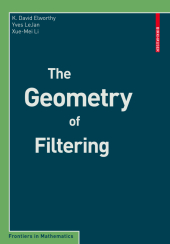 Neuerscheinungen 2010Stand: 2020-01-07 |
Schnellsuche
ISBN/Stichwort/Autor
|
Herderstraße 10
10625 Berlin
Tel.: 030 315 714 16
Fax 030 315 714 14
info@buchspektrum.de |

K. D. Elworthy, Yves LeJan, Xue-Mei Li
(Beteiligte)
The Geometry of Filtering
2010. xi, 169 S. XI, 169p. 24 cm
Verlag/Jahr: SPRINGER, BASEL; BIRKHÄUSER BASEL 2010
ISBN: 3-03-460175-1 (3034601751)
Neue ISBN: 978-3-03-460175-7 (9783034601757)
Preis und Lieferzeit: Bitte klicken
The geometry used in this book is that determined by a map of one space N onto another, M, mapping a diffusion process, or operator, on N to one on M. That geometry is considered in situations of geometric, stochastic analytic or filtering interest.
Filtering is the science of nding the law of a process given a partial observation of it. The main objects we study here are di usion processes. These are naturally associated with second-order linear di erential operators which are semi-elliptic and so introduce a possibly degenerate Riemannian structure on the state space. In fact, much of what we discuss is simply about two such operators intertwined by a smooth map, the \projection from the state space to the observations space", and does not involve any stochastic analysis. From the point of view of stochastic processes, our purpose is to present and to study the underlying geometric structure which allows us to perform the ltering in a Markovian framework with the resulting conditional law being that of a Markov process which is time inhomogeneous in general. This geometry is determined by the symbol of the operator on the state space which projects to a symbol on the observation space. The projectible symbol induces a (possibly non-linear and partially de ned) connection which lifts the observation process to the state space and gives a decomposition of the operator on the state space and of the noise. As is standard we can recover the classical ltering theory in which the observations are not usually Markovian by application of the Girsanov- Maruyama-Cameron-Martin Theorem. This structure we have is examined in relation to a number of geometrical topics.
1 Diffusion Operators.- Representations of Diffusion Operators .- The Associated First Order Operator.- Diffusion Operators Along a Distribution.- Lifts of Diffusion Operators .- Notes.- 2 Decomposition of Diffusion Operators.- The Horizontal Lift Map.- Example: The Horizontal Lift Map of SDEs .- Lifts of Cohesive Operators and The Decomposition Theorem.- Diffusion Operators with Projectible Symbols.- Horizontal lifts of paths and completeness of semi-connections.- Topological Implications.- 3 Equivariant Diffusions on Principal Bundles.- Invariant Semi-connections on Principal Bundles.- Decompositions of Equivariant Operators.- Derivative Flows and Adjoint Connections.- Vector Bundles and Generalised Weitzenböck Formulae.- 4 Projectible Diffusion Processes.- Integration of predictable processes.- Horizontality and filtrations.- The Filtering Equation.- A family of Markovian kernels.- The filtering equation.- Approximations.- Krylov-Veretennikov Expansion.- Conditional Laws.- Equivariant case: skew product decomposition.- Conditional expectations of induced processes on vector bundles.- 5 Filtering with non-Markovian Observations.- Signals with Projectible Symbol.- Innovations and innovations processes.- Classical Filtering.- Examples.- 6 The Commutation Property.- Commutativity of Diffusion Semigroups.- Consequences for the Horizontal Flow.- 7 Example: Riemannian Submersions and Symmetric Spaces.- Riemannian Submersions.- Riemannian Symmetric Spaces.- 8 Example: Stochastic Flows.- Semi-connections on the Bundle of Diffeomorphisms.- Semi-connections Induced by Stochastic Flows.- Semi-connections on Natural Bundles.- 9 Appendices.- Girsanov-Maruyama-Cameron-Martin Theorem.-Stochastic differential equations for degenerate diffusions.- Semi-martingales and G-martingales along a Sub-bundle.


